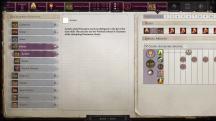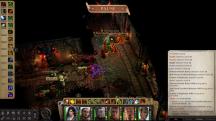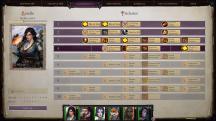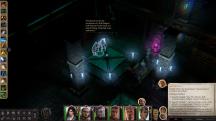Pathfinder: Wrath of the Righteous Early Access Review

In 2018, Owlcat Games pleasantly surprised cRPG fans with their debut title, Pathfinder: Kingmaker, widely considered as one of the best spiritual successors of the Baldur’s Gate series. A year after the release of Kingmaker, Owlcat Games revealed their second title, Pathfinder: Wrath of the Righteous, and a Kickstarter campaign was launched in February 2020.
Wrath reached its initial funding goal within a day of the Kickstarter launch and ended up raising $2 million in total. Several great stretch goals were unlocked during the Kickstarter campaign – most notably:
- 2 additional mythic paths - Swarm-that-walks and Gold Dragon, on top of the originally planned 7.
- New races - Oread and Kitsune, in addition to the originally planned Dhampir.
- New classes - Warpriest, Cavalier, Skald and Hunter, in addition to the originally planned Arcanist, Bloodrager, Oracle, Shaman and Witch.
- New Prestige class Winter Witch, in addition to the originally planned Hellknight, Hellknight Signifier and Student of War.
- One additional archetype per class which will add up to a total of 6 archetypes per class at its release.
As I thoroughly enjoyed Kingmaker, I have been closely following the development of Wrath and participated in the pre-alpha, alpha and beta test phases. Having recently finished my beta run, I can confidently say Wrath is an improvement over Kingmaker in almost every aspect.
Before you read any further, just note that this preview may contain some minor spoilers and I have used a custom portrait for my player character in my screenshots.
I can’t wait to play as an Angelfire Apostle coupled with the acolyte background!
Pathfinder: Wrath of the Righteous is based on an existing Paizo adventure path module like its indirect predecessor, Pathfinder: Kingmaker. However, the tone of Wrath is more mature, dark and epic compared to Kingmaker. This time, players embark on a journey to a realm overrun by demons as a Mythic hero, capable of feats beyond mere mortals. Such power comes at a great cost, and you will need to carefully decide how you shape the mysterious powers bestowed upon you or you may end up potentially losing them, along with your companions or your very humanity. The Mythic path system is undoubtably the most unique and important feature in Wrath, as it not only adds a layer of complexity and fun to class building but also a tremendous amount of replayability to the game.
There currently are 6 different mythic paths to choose from in the beta - Angel, Azatas, Aeon, Trickster, Lich and Demon, while the full game will also feature Gold Dragon, Swarm-that-walks and Legend mythic paths. I chose to play as a Trickster heroine in the beta and also tried out the Angel and Azatas mythic paths in the alpha – all 3 runs were extremely enjoyable as Owlcat Games did a fantastic job at fleshing out each path according to their own theme.
As a Trickster, I was able to prank both my allies and enemies alike. While I was a little uneasy tricking my allies, I had great fun playing some nasty jokes on my enemies – there were so many great moments that I felt I could *almost* relate to the Lantern King, the infamous fey prankster Elder in Kingmaker.
Azatas was my favourite path so far with lots of whimsical and chaotic but seemingly harmless choices. You can invite all sort of strange misfits to join your army, decide on how you will decorate your very own floating rock above the clouds, and you get a cute little friend who loves chocolates and cookies a little too much.
Although the Angel path felt a bit cliched compared to the Trickster and Azatas, it was still an extremely satisfying experience playing as a protector of good. The Angel mythic also comes with lots of powerful abilities and is considered one of the two most flexible mythic paths that can work with many class choices.
Choices, choices… which mythic path would you choose?
Each of the 6 mythic paths in the beta comes with their own mythic abilities and spell books aligned to their theme. As the mythic path progression tree is not visible during character creation, I chose the class which I felt matched the theme of each mythic path. While my class/mythic choices would not be considered ‘meta’ or ideal, I still had a lot of fun and equally as powerful in my runs playing as a Warpriest/Angel and then Arcane Trickster/Trickster.
There are also mythic exclusive quests and storylines for each path, which provides different viewpoints and insights on certain events and characters depending on your chosen mythic. For example, an Angel mythic hero will find out what role a certain demon played in the demise of Lariel, an important early figure and for what purpose – a revelation that’s hidden from other mythics.
All 6 mythic paths are assigned unique mentors and a hub of sorts, while some mythic paths get their own specific companions. Mythic mentors will share their opinion on lots of matters and you can decide whether you want to heed their advice or not, however this will have a huge impact on the development of your mythic powers as the game progresses.
Each mythic path will also be able to resolve several shared quests in a different way which doesn’t become apparent until you replay the game – for example, Azatas gets an option to persuade your allies to rush to a hidden demon lair and prevent a bunch of slaves from suffering a horrific fate, while other mythic paths have no choice but to wait for Queen Galfrey to arrive first.
Fish. Missile. You know its good when a game lets you fling flapping fish at firey fiends.
It’s important to note that you don’t start off your journey by choosing which mythic path to follow. As the story progress, you will be able to unlock different mythic paths by performing certain actions and/or obtaining specific objects. It wasn’t difficult to unlock all 6 mythic paths as specific dialogues and actions will be hinted with the relevant mythic theme song playing in the background. It’s worth pointing out that each of the 6 mythic theme scores are beautiful, perfectly representing their respective mythic paths which really adds to the atmosphere.
In the early game, you will simply level up as a mythic hero until you get a choice to lock in 1 of 6 mythic paths towards the end of chapter 2. At this stage, there is no alignment restrictions in unlocking the initial mythic paths, as you are still in a process of shaping your power. The full mythic transformation will take place in the later stages of the game - we were not able to experience it in the beta, which consisted of the first 4 chapters. Once you lock in your initial path, your actions and alignment will have to match the chosen mythic as it is likely that you may not gain full access to your chosen mythic powers if you deviate in alignment. Should you wish to, and fulfil the relevant requirements, players will likely be able to switch mythic to 1 of 3 paths available in the late game - Gold Dragon, Swarm-that-walks or Legend instead of fully investing in their initial mythic. This also provides players the freedom to redeem themselves for good, or corrupt their powers to evil.
Mythic hero progression is a lot more intricate than Mythic companion progression
Mythic powers that you receive also flow down to your companions, albeit in much less powerful and more restricted form. As companions don’t get to choose their own mythic path, they only get access to a shared pool of generic mythic abilities, which you also have access to in early game as a mythic hero before you lock in a path.
There are 12 potential companions available in the beta, including Woljif Jefto who was added as part of a Kickstarter stretch goal. Companions in Wrath have very vivid and quirky personalities, which resulted in me having clear favourites and dislikes in the early stages of the game. However, as the story progressed, I came to appreciate each and every companion for who they are. I never imagined that I would come to respect and rely on an evil Hellknight so much, heed the wisdom of a child clearly detached from reality, or make a conscious choice to let a girl with questionable morals stay in my party because I was curious to see how her story unfolded. Most companions are delightfully crazy in their own way and they do fantastic job of lifting up the gloomy underlying atmosphere in Wrath when needed.
Companions in Wrath have a lot more banter and interjections which makes them feel much more alive than their Kingmaker counterparts
You will get access to 3 companions in the prologue and a further 4 companions will be recruitable in chapter 1, while some companions won’t show up until as late as chapter 3.
The prologue and chapter 1 act as a tutorial, especially for those who aren’t familiar with Pathfinder rules. Owlcat Games implemented an enhanced interactive tutorial which I found rather delightful as relevant information pops up based on gameplay. This feature seems to require a bit more work as I have seen a number of tutorial messages with incorrect information appear due to too generalised rule triggers. As an example, a tutorial message appeared pointing out that Daeran, a spontaneous spell caster, gained a free slot to memorise spells upon him levelling up. While this is a potentially useful reminder to new players, it is also confusing if they aren’t aware that spontaneous casters don’t need to memorise spells. Owlcat Games is aware of these inconsistencies, and will hopefully have them ironed out in the full release.
The interactive tutorial provides an in-depth explanation of what is happening and how you can overcome the issue
Another improvement I really liked is that the game UI now shows which items and buffs have non-stacking bonuses. It was quite a shock to realise just how often I was casting buffs that were not required anymore and this feature was extremely useful to cull out spells and abilities that were no longer practical as I geared up.
Wrath has a plethora of equipment slots – from goggles on top of circlets, to stylish robes on top of armour
The story progression from the prologue to chapter 1 is linear and takes place in the city of Kenabres. After surviving a devastating and unexpected demon attack, you are tasked with gathering allies scattered all over the city and guiding them to a rally point in order to build a strong enough force to storm the Grey Garrison and retake Kenabres from the demons.
Once successful in that task, you will be appointed as a Knight commander by Queen Galfrey as she declares the beginning of the Fifth Mendevian Crusade. Your objective now is to raise an army to retake Drezen, a city-fortress which was overtaken by the demonic hordes of the Worldwound during the First Mendevian Crusade.
While the player party can travel past most of the demon legions in the world map, you will have to defeat a number of demon fortresses with your crusading legions before being able to travel beyond. Each of your legions has its own morale, strength and detailed unit composition, for example one of my legions was composed of 1 unit of 110 archers, 1 unit 8 clerics and 2 units of footmen – one with 119 footmen and another with 110 footmen. In combat, high morale provides a chance for units to take an additional action in a round, while negative morale introduces a chance for units to become dazed or skip an action in a round. Army strength measures the total strength of each legion and allows players to make an informed decision on the likelihood of victory when in combat with an enemy army. Upon defeating each demon legion, your legions will receive experience points and other rewards such as materials required to hire specific army units and leaders. Each of your units possesses relevant class abilities – for example, paladin units can cast smite evil and lay on hands. Similarly, legion leaders also come with a variety of abilities and spells while also allowing each legion to learn additional skills as they gain more experience. While you can hire several leaders for your army, only one leader can be assigned per legion.
Owlcat Games took inspiration from the Heroes of Might & Magic series for army combat and management in Wrath
Retaking Drezen concludes chapter 2 and allows you to use the city as your base, thereby expanding the scope of army management beyond just combat. It is worthwhile noting that the army management feature is still very much in draft phase and the beta had lots of missing features and texts. The basics of army management appear to be similar to Kingdom management in Kingmaker, minus the dice roll success and failures. You will be able to assign your party members to 4 advisor positions and each companion fulfills their role by providing you with advice when needed, completing projects to help raise army morale, unlock different army units, craft magical items and appeal to the crusade’s supporters such as noble houses and the royal court. You will also be able to construct a variety of buildings, such as barracks and archery ranges, in the fortresses you control in order to increase the number of units you can raise per week. I felt that army management system was more integral to the gameplay and story elements of Wrath, instead of a separate mini-game as in Kingmaker’s kingdom management, which I believe is a strong positive change.
Chapter 3 takes a more open world approach following the rather linear progression of the story up until to the conclusion of chapter 2, and was by far the longest chapter in the beta with many new features introduced. While players have much more freedom to explore the Worldwould at their own pace, you may end up visiting some of the areas tied to the main plot much earlier than planned depending on your chosen mythic path – this also means some paths will gain mythic levels much earlier than others as mythic level is tied to story progression rather than the amount of experience gained.
It’s not all twisted hellscapes - You will get to visit many different locations with varied aesthetics, including some nice outdoor areas!
As your forces establish a strong presence in and around Drezen, your allies will start to show up including some familiar faces from Kingmaker. Storyteller makes a return but this time he is interested in finding out about his own past which seems to be closely tied to the main plot of Wrath.
The story also picks up the pace in chapter 3. The main antagonist of the game openly approaches you for the first time towards the end of chapter 2, revealing more of her intentions while showing a particular interest in you throughout chapter 3. The story deepens in chapter 4 where you get to travel to the heart of demon operations and gain insights on the connection between the main antagonist, some of her notable allies and their overarching plans. As with companions, Owlcat Games did an excellent job at developing the notable demon characters. I couldn’t help but fall in love with some of them and even tried my hardest to save them from trouble in a few occasions.
What plans does she have in store for us… for the whole world?
Unfortunately, chapter 4 in the current version of the beta is relatively unfinished with most of the mythic specific and companion quests either unimplemented or broken. It is fair to say that there are still a lot of features that need to be implemented and fixed before the full release of the game. Despite this, I played through all of the beta in Real Time with Pause mode without encountering major technical issues and found the beta fairly polished and in a similar state to Kingmaker at its release. Others playing the beta in Turn Based mode seemed to encounter more issues, with the most common complaint being characters getting stuck at doorways during the combat.
Wrath beta provided me with more than 75 hours of pure enjoyment as a completionist. As the full game will include 2 more chapters, my impression is that Wrath could be roughly the same length as Kingmaker but with tremendously more replayability. While those who are short on time will get plenty of joy out of a single playthrough, I believe many players who delve into Wrath wouldn’t be able to resist replaying the game to explore other mythic paths.
Wrath of the Righteous is currently targeted to release in Q3 2021. While the current version of the beta, which was released back in February 2021, is still in rather a rough form, I look forward to playing the updated beta which is planned to be released at the end of April. Having played through pre-alpha to beta versions of the game, I am cautiously optimistic that Wrath of the Righteous will be released in a decently polished and complete form in Q3 2021.
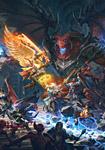
Information about
Pathfinder: Wrath of the RighteousDeveloper: Owlcat Games
SP/MP: Single-player
Setting: Fantasy
Genre: RPG
Combat: Pausable Real-time
Play-time: Unknown
Voice-acting: Unknown
Regions & platforms
Internet
· Homepage
· Platform: PC
· Released: 2021-09-02
· Publisher: META Publishing
More information



